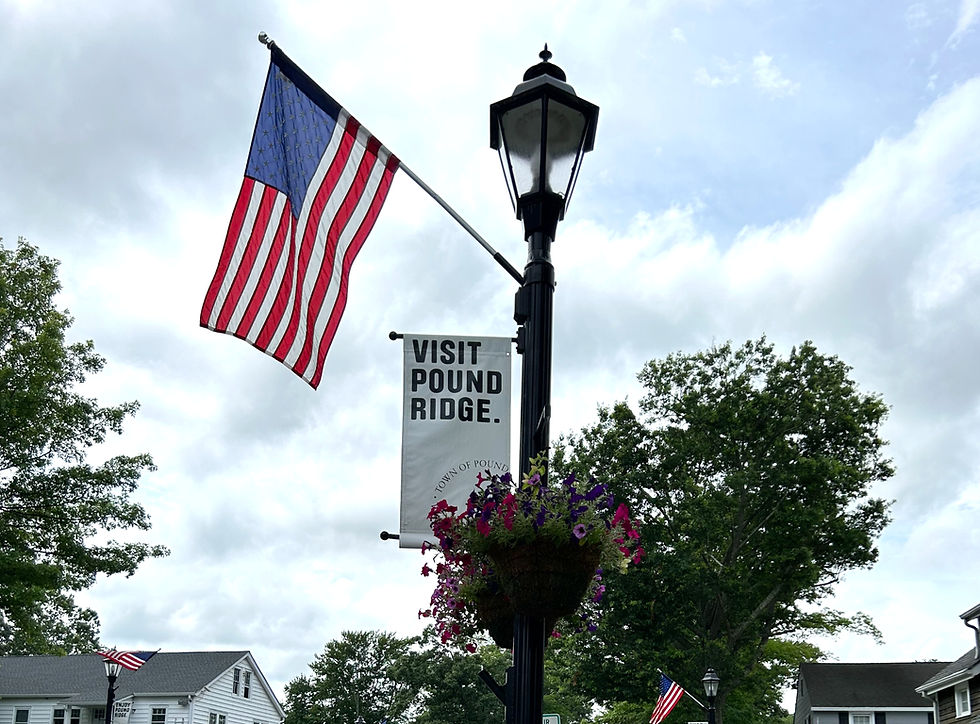Lewisboro history: The ‘Lost Village’ of Lake Kitchawan keeps its secrets
- Maureen Koehl
- 2 days ago
- 4 min read


By MAUREEN KOEHL
It’s hard to imagine the changes in the land that can take place over decades, and maybe centuries. During that time, abandoned pastures grow up to become forestland, streams change course and ponds morph into swampland. About all that remains constant are the rock outcroppings and general topography. Our wonderful stone fences stand testament to our forebears; houses collapse or burn, but their stone foundations remain and these remnants of a century ago are what I set out to explore with lifelong Lake Kitchawan resident and history buff, Ron Egloff, on a decade-ago spring day. We were in search of the “Lost Village.”
Located between Lake Kitchawan in Lewisboro and Trinity Lake in Pound Ridge is an area called the Lost Village, populated during the second half of the 19th century. Once a settlement of at least four families, it is said the area was decimated by illness close to the turn of the 20th century. The homes of the families of basket maker Matthew Austin, farmer Harry Austin, Stephen Bouton, seller of wild huckleberries, all of Pound Ridge, and the DeForest family of Lewisboro dotted the hills and valleys of what is now part of the Stamford Watershed property. As we walked along what used to be a farm road, Egloff pointed out several of the foundations that he used to explore as a kid growing up in Lake Kitchawan. Back then, artifact hunters dug up pottery shards, broken window glass, and other detritus left when homes were abandoned.
That day, we didn’t dig deep enough through the leaves to find charred wood or melted glass, but in an article circa 1979, Lewisboro Ledger editor William Lynch III reported finding such items and spotted a log roof covering one of the foundations.
Jay Harris, in her book of Pound Ridge history, “God’s Country” (Pequot Press, 1971), describes the Lost Village, also referred to as “The Regions.” The reason for the abandonment of the settlement, Harris wrote, was likely illness, probably tuberculosis, dysentery or typhus, maladies that were rampant in those times. Were the houses torched to combat the spread of disease? Was there a devastating fire caused by a lightning strike? We will never know, but this history mystery has been left for current generations to solve. Where there were once lilacs and fruit trees and huckleberry bushes, invasive barberry now rules the land.
The family names associated with the Lost Village were once a strong presence in our two towns. DeForest is still on the maps as DeForest Trail at the southern end of the Lake Kitchawan community, and DeForest was the owner of the lakeside store that became Lake Kitchawan Casino.
Curious to know if our town records showed any large outbreaks of disease in the area, I tried a very limited search and found little concentrated disease contemporary with the supposed end of the settlement. I did find one note about 40-year-old Mariah DeForest, a housewife and pauper, who was committed to the Westchester County Poor House in 1875. The woman apparently suffered from St. Vitus’ dance [Sydenham’s chorea]. The prognosis was not good. However, there was no address given, so we really can’t place poor Mariah in the Lost Village, but we can continue to wonder about this mysterious place.
During that same time period, railroads were all the rage and an ambitious plan to run a line from Port Chester to Danbury, Conn. was proposed. Farmers bought stock or were eager to sell their land to the project, but a downturn in the economy brought an end to the project by 1890 — and lucky that it did. The railroad tracks would have replaced Mill River Road and the eastern part of what is now the Leon Levy Preserve on their way to Ridgefield, Conn. The berm that was engineered can still be seen along the eastern bank of the Mill River as it approaches Smith Ridge Road.
Lake Kitchawan has had other secrets to reveal over the decades. In the early 1970s a college student at the State University of New York at Purchase saw a bone sticking out of an area where work was being done on one of the canals leading from the lake. An official archaeological dig revealed 10,000-year-old mastodon bones. A jawbone, teeth and other bones are now housed at the Trailside Nature Museum in the Ward Pound Ridge Reservation and the Pound Ridge Historical Society Museum.
There is one last mystery to be solved before we leave Lake Kitchawan. Egloff told me about three large, probably flat-bottomed boats sunk in the lake. As near as can be determined, the boats are about 30-feet long with a 10-foot beam. Where did they come from? What was their purpose in the small lake with no access to a larger body of water? Do they date as far back as the early 19th century, as Ron thinks they might, and if so, might they have been used for transporting logs down the lake from a hillside logging operation?
One thing we do know is this area of the town was always well-used. Long before the steep hillsides were developed as summer places and then after World War II became the sites of permanent residences, Native Americans roamed in search of game and foraged for nuts and berries. Stephen Bouton wasn’t the first one to exploit the huckleberry crop! Over time, area residents turn up spear points and arrowheads when preparing their gardens in the spring. With the discovery of the mastodon bones, we know that large game was present. Where there is one mastodon, there must have been a companion.
For more information about Lake Kitchawan, read Egloff’s chapter in “A History of Lewisboro” available to read or purchase at the Lewisboro Library.
Maureen Koehl is the Lewisboro town historian.





![CA-Recorder-Mobile-CR-2025[54].jpg](https://static.wixstatic.com/media/09587f_b989949ec9bc46d8b6ea89ecc2418a8a~mv2.jpg/v1/fill/w_370,h_150,al_c,q_80,enc_avif,quality_auto/CA-Recorder-Mobile-CR-2025%5B54%5D.jpg)
![CA-Recorder-Mobile-Mission-2025[26].jpg](https://static.wixstatic.com/media/09587f_9ea6e7e6084c40cc9b62653360503cbc~mv2.jpg/v1/fill/w_370,h_150,al_c,q_80,enc_avif,quality_auto/CA-Recorder-Mobile-Mission-2025%5B26%5D.jpg)


